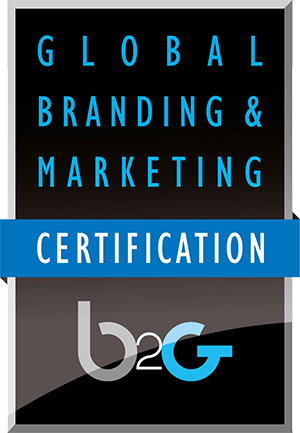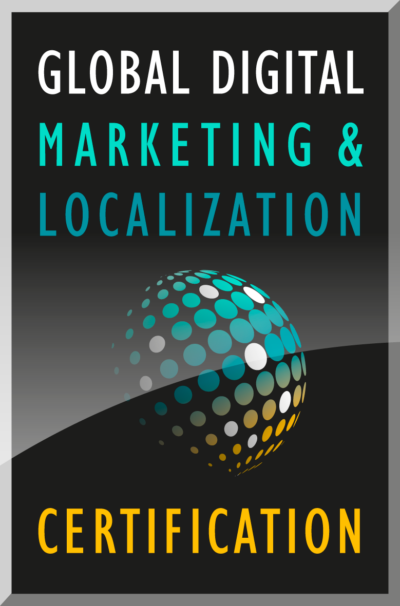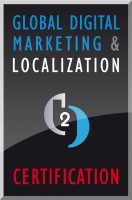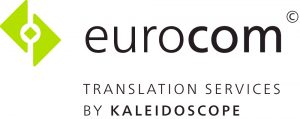This is the final paper presented by Anita Wilson, a recent graduate of the Global Digital Marketing and Localization Certification (GDMLC) program. This paper presents the work being produced by students of The Localization Institute’s Global Digital Marketing and Localization Certificate program. The contents of this Paper are presented to create discussion in the global marketing industry on this topic; the contents of this paper are not to be considered an adopted standard of any kind. This does not represent the official position of Brand2Global Conference, The Localization Institute, or the author’s organization.
As a Language Service Provider (LSP), Eurocom is at the forefront of helping our clients develop an understanding of how to tackle international markets and widen their customer base. Moreover, we feel it is our duty as a service provider to do so – who is better equipped than a company that is comprised of individuals educated in multiple languages and cultures, and with close links to experts such as translators, copywriters, SEO specialists etc. around the globe?
The first step to developing a truly successful global strategy is to view the client-LSP relationship not as a client-supplier relation, but as a partnership. We can observe this on a regular basis: when a partnership is established, it helps both the client and the LSP develop a deeper understanding of the matter of localization. Going international is not a one-way street; in fact, a strategy only truly works when both sides are willing to learn from each other.
The importance of a global presence in the digital market has been proven in studies time and time again. Common Sense Advisory (CSA) research shows that it takes a website in 14 languages to allow companies to reach out to 90% of the online business community. It takes considerably more effort (a further seven languages) to reach 95% (Sargent and DePalma, 2015).
Amongst the Eurocom client base, which is comprised predominantly of medium-sized enterprises in the DACH region, this international approach becomes even more important. When the marketing content source language is not English (in our clients’ case it is usually German), English as a first localization language is almost a given to help companies get a foot in the door of international customer communication.
Looking at the global presence of our own clients, it becomes obvious that localisation of marketing content into English is always part of the strategy. This is supported by CSA research, which shows that the share of online GDP for English is 36.28%, with a 20.6% share of the global online audience (Sargent, 2016). Additionally, many customers especially in the B2B sector claim a high proficiency of the English language and can be reached this way. Maybe surprisingly though, when it comes to making purchasing decisions, B2B buyers are even more conservative than consumers: 80% are more likely to purchase a product when information is available in a language other than English (compared to 75% of consumers) (Ray and DePalma, 2016).
As an LSP with over 25 years’ experience, we have seen globalization efforts go horribly wrong (often when there was no coordinated approach), but we also have examples of where clients got it successfully right. The following section summarizes the characteristics of successful localization models we have witnessed as best practice.
The points below are designed to serve as a guide for any company developing a digital marketing localization model, as well as for LSPs as a guide on how to provide support for clients on this digital journey.
The key to a successful model is to work with the right partners:
Digital marketing agency/specialists/developers: select partners who are open to process input from all other parties involved. We have experienced agencies convinced that only their approach and processes can work, and have seen this approach become very counterproductive when they then tried to force their processes upon to everyone else – regardless of whether there may have been an alternative, more efficient, time- and/or cost-saving approach.
Each partner has unique expertise in their own field (and should be willing to listen to others when it comes to topics touching on others’ areas of expertise). For instance, we have come across CMS developers who are convinced it is best practice to translate directly into the CMS, without regard for CAT tools, translation memory and termbase technology, and quality assurance processes in translation projects.
Another example would be a marketing agency that creates great campaigns in the source language without thinking about whether the metaphors/images/phrases can be transported into other languages. This usually entails a long-winded process of trying to make something work in other languages that simply won’t, and leaves everyone with a product they are not happy with – and in the worst case with a campaign that leaves potential new customers completely unimpressed.
Just as important is the selection of the right LSP. Ensure the LSP is experienced in global digital marketing projects. It is common practice to ask for references from similar projects, and to have the potential agencies show their expertise by sharing (anonymous) translator CVs, providing test translations and generally have them explain their processes and approach to this kind of project to you. Other important factors are access to a single point of contact (a dedicated project manager), the possibility for in-country reviewers to speak to the translators directly, IT experienced in digital formats and a good (if possible online) platform for reviews.
Once the partners have been identified, allow them to form a team:
This involves direct contact between all parties. Of course there will always be a project lead on the client’s side that is kept up to date on all developments. However, direct contact makes communication go much more smoothly and efficiently.
Help LSP and other partners understand your market:
The better the partners are involved in the client’s strategy, the more they will identify with the project and deliver the results the client envisage. Good partners should be eager to learn all about a company and its projects, terminology, understand the project brief and deliver valuable input to improve the campaign even further.
Trust your LSP and learn from their expertise:
Often, clients do not know where to start when developing a localization strategy. Ask your LSP for advice. From best practices from past projects to pointing you in the right direction for research findings and industry associations, they can deliver invaluable expertise which you can utilize in your campaigns.
Involve your LSP as early as possible:
Ideally at the stage when you select a CMS, or have your existing CMS adapted to support new langauges. Your LSP will not want to make the tool decision for you. However, they can deliver invaluable input regarding the “translatability” of CMS content. The LSP is likely to be experienced in different CMS tools already, and may be able to recommend plug-ins that allow (XML) exports of web content. A good preparatory step once exports are available is to carry out a so-called pseudo translation to test whether translated content can be re-imported into the CMS.
Decide what role local subsidiaries will play:
The most successful localization campaigns we have witnessed have allowed local subsidiaries to play an important role in the localisation process. This role does not have to involve having the final say in everything. But it should involve being allowed to give input on marketing content, whether slogans, images etc. can work in the local market, and on translation. Ensuring the local market is happy with the translation style is key to a successful local online presence. Eurocom has gone so far as to have translators trained on clients’ products/services in the local subsidiary, have round table meetings to discuss terminology and style preferences, and generally foster an active exchange between translators and local clients.
Our Eurocom experience clearly shows: viewing the LSP not purely as a company that provides translations, but as a true “service provider” with years of expertise in various languages, cultures, and projects, is the perfect approach taken by successful global companies. This is an ideal way to avoid extensive localization projects spinning out of control. It is always more expensive trying to fix problems after they occur than to put proper planning in place with the right partners from the outset of a project. Getting a disgruntled customer to return after something has gone wrong is often difficult if not impossible. LSPs as partners are happy to help and enthusiastic about their specialist subject. Tapping into this expertise is a sure way to create a joint model for successful (digital) localization which will stand the test of time.
References:
Benjamin B. Sargent and Donald A. DePalma (Common Sense Advisory). 2015. The Rise and Fall of the Top Online Languages.
Rebecca Ray and Donald A. DePalma (Common Sense Advisory). 2016. Pragmatic Global Content Strategy.
Benjamin B. Sargent (Common Sense Advisory). 2016. Digital Opportunity: Top 100 Online Languages for 2016.
Copyright © 2016 The Localization Institute. All rights reserved. This document and translations of it may be copied and furnished to others, and derivative works that comment on or otherwise explain it or assist in its implementation may be prepared, copied, published, and distributed, in whole or in part, without restriction of any kind, provided that the above copyright notice and this section are included on all such copies and derivative works. However, this document itself may not be modified in any way, including by removing the copyright notice or references to The Localization Institute, without the permission of the copyright owners. This document and the information contained herein is provided on an “AS IS” basis and THE LOCALIZATION INSTITIUTE DISCLAIMS ALL WARRANTIES, EXPRESS OR IMPLIED, INCLUDING BUT NOT LIMITED TO ANY WARRANTY THAT THE USE OF THE INFORMATION HEREIN WILL NOT INFRINGE ANY OWNERSHIP RIGHTS OR ANY IMPLIED WARRANTIES OF MERCHANTABILITY OR FITNESS FOR A PARTICULAR PURPOSE.
Author Bio:
Anita Wilson is Managing Director of Austria’s largest and most innovative translation agency, eurocom Translation Services. After obtaining a Master‘s Degree from the University of Salzburg in English Language and Literature as well as Communication Studies she lived in Northern Ireland and Scotland. She joined eurocom in 2009 where she specialises in the day-to-day operations of the company as well as the subject areas of marketing and transcreation.
Connect on Social Media:
LinkedIn : https://www.linkedin.com/public-profile/settings?trk=prof-edit-edit-public_profile
Facebook: https://www.facebook.com/TranslateYourBiz
Twitter: @TranslateTheBiz
Company Bio: http://www.kaleidoscope.at/en/eurocom











